 Esmé Warmuth
Esmé Warmuth


 Esmé Warmuth
Esmé Warmuth

told my friend last night while we were walking to the Press office that I feel like a piece of kelp in the ocean. Not in a good way or a bad way — kelp doesn’t care that it bends to the will of the current, it’s just kelp. It’s seaweed. It wiggles under the water, sucks up nutrients from fish poop and rotting carcasses on the seafloor, photosynthesizes.
As of writing this, my 22nd birthday is tomorrow. I never had a birthday at Chuck E. Cheese growing up — I never even bothered asking. I just knew the answer would be no. I don’t know why. But I think it was Carly Hinman who had her birthday party at a Chuck E. Cheese when we were in first or second grade. I didn’t pay much attention to the games because I always lost, but the jungle gym never ceased to entertain me. I climbed up the steps into the multicolored tunnel. I went through every turn I could find, just in case there was one corner where something amazing was hiding just around the tunnel’s bend. I slid down the slide and landed in the ball pit, then waded out as quickly as possible so I could go up the stairs and crawl into those red, yellow and blue tubes — so hidden and wonderful to me — once again.
I used to go to McDonald’s multiple times a week when I was a little kid. My grandmother and aunt, the main culprits of my McDonald’s habit, used to say that if I ate any more chicken nuggets, I’d become one. One time, I crawled to the top of the tunnels in a PlayPlace and found a scratched porthole that overlooked the seating area, where my grandmother sat drinking her unsweetened iced tea with lemon from the Dunkin’ Donuts across the street. There, on the textured floor of that red tube, was a small puddle of yellow-gray vomit — completely smooth, no chunks. My little body, rattled and sheet-white, scuttled back down the greasy slides and tunnels and steps, and I stepped back out in the regular dining area. I finished my chicken nuggets and fries without saying anything. My grandmother and I left. I haven’t been in a McDonald’s PlayPlace or a Chuck E. Cheese jungle gym since that day.
My 22nd birthday party will not be held at Chuck E. Cheese — none of my birthdays will. Is this sad? I’m a stalk of kelp in the water. I never sway too far in any direction, I can feel the air bubbles come up through my yellow-green leaves — it tickles. That’s nice. Maybe you’re wondering if any of this means anything: Is the kelp a metaphor? Are the tunnels a metaphor? Is the vomit? I will answer those questions for you: No. They are all just things that I’ve seen and felt. Did you see them? Do you feel like this too?
APRIL/MAY 2023
Executive Editor
Managing Editor
Associate Editor
Business Manager
News Editors
Opinions Editor
Features Editors


Culture Editors
Music Editors
Science Editors
Satire Editors
Lead Copy Editor
Copy Editor
Multimedia Editors
Graphics Editors Ombud Team
Keating Zelenke
Jane Montalto
Samantha Aguirre
Rafael Cruvinel
Lauren Canavan
Sydney Corwin
Julio Taku
Matt Hono
Antonio Mochmann
Dylan Gallo
Michael Kearney
Lauren Canavan
Rafael Cruvinel
Jessica Castagna
Sydney Corwin
Jessica Castagna
Ali Jacksi
Melanie Formosa
Esmé Warmuth
Komal Grewal
Naomi Idehen
Antonio Mochmann
Komal Grewal
Naomi Idehen
Michael Kearney
Elizabeth Lai
Keating Zelenke
Arun Nair
Emily Scott

The Press is located on the third floor of the SAC and is always looking for artists, writers, graphic designers, critics, photographers and creatives!
Meetings are Wednesdays in SAC 307K at 1 PM and 7:30 PM.
Scan with Spotify to hear what we’ve been listening to lately:


Maya Hawke has been a champion of queer rights and awareness since the beginning of her acting career. In 2019, she debuted the role of Robin Buckley in season three of Netflix’s Stranger Things, creating arguably one of the most mainstream, widely beloved lesbian characters in television history. “If I can hope for anything, it’s that maybe some people fell in love with Robin, and that helped them fall in love with girls who love girls, and boys who love boys,” she stated in an interview for Variety following the release of the show.
Following the release of Stranger Things, Hawke ap-
peared in several other projects centered around sapphic characters, including Fear Street (2021) and Do Revenge (2022). Through the promotion of these projects, Hawke continued to speak openly and frequently about her hopes that young people will see themselves reflected in her characters.

In addition to acting, Maya Hawke has released two albums and multiple singles, taking inspiration both from her own life and from the world around her. Much like her acting roles, many queer fans have found their own experiences reflected in Hawke’s music over the years. In the song “To Love a Boy” from her 2019 debut album Blush, she describes the feeling of being afraid you can’t
love who you’re supposed to. Softly, Hawke sings:
I want to love a boy the way I love the ocean
Wish I was not afraid of all I have that’s broken
I know I must behave to contain all my emotion
But I want to love a boy the way I love the ocean
In the bridge of the song, she goes on to sing:
I ask why, it’s better to speak than it is to die
This line seems to reference the 2007 novel Call Me By Your Name, a
queer classic, in which the main character poses the question “Is it better to speak, or to die?” in reference to confessing his feelings for a male friend.
Many lesbians have taken comfort in the bittersweet, queer interpretation of this song — the ubiquitous feeling that things would be easier if they could fall in love with a boy.
Many of Hawke’s songs have included similar references to the ocean. She frequently includes mermaid imagery, seemingly as an allegory. This potentially queer allegory can first be seen in the music video for “To Love a Boy.” In the video, Hawke dresses as a mermaid, appearing out of place in the streets of Los Angeles. She shows her desire to fit in but ultimate failure to assimilate. The video concludes with her returning—alone—to the ocean. Her personal intention behind the lyrics remains largely undiscussed, perhaps to allow the listener to form their own interpretation of her words, though recently while introducing “To Love a Boy” in concert
she said, “When I wrote it, I really, really wrote it about the ocean…but I don’t not relate to its implications.”
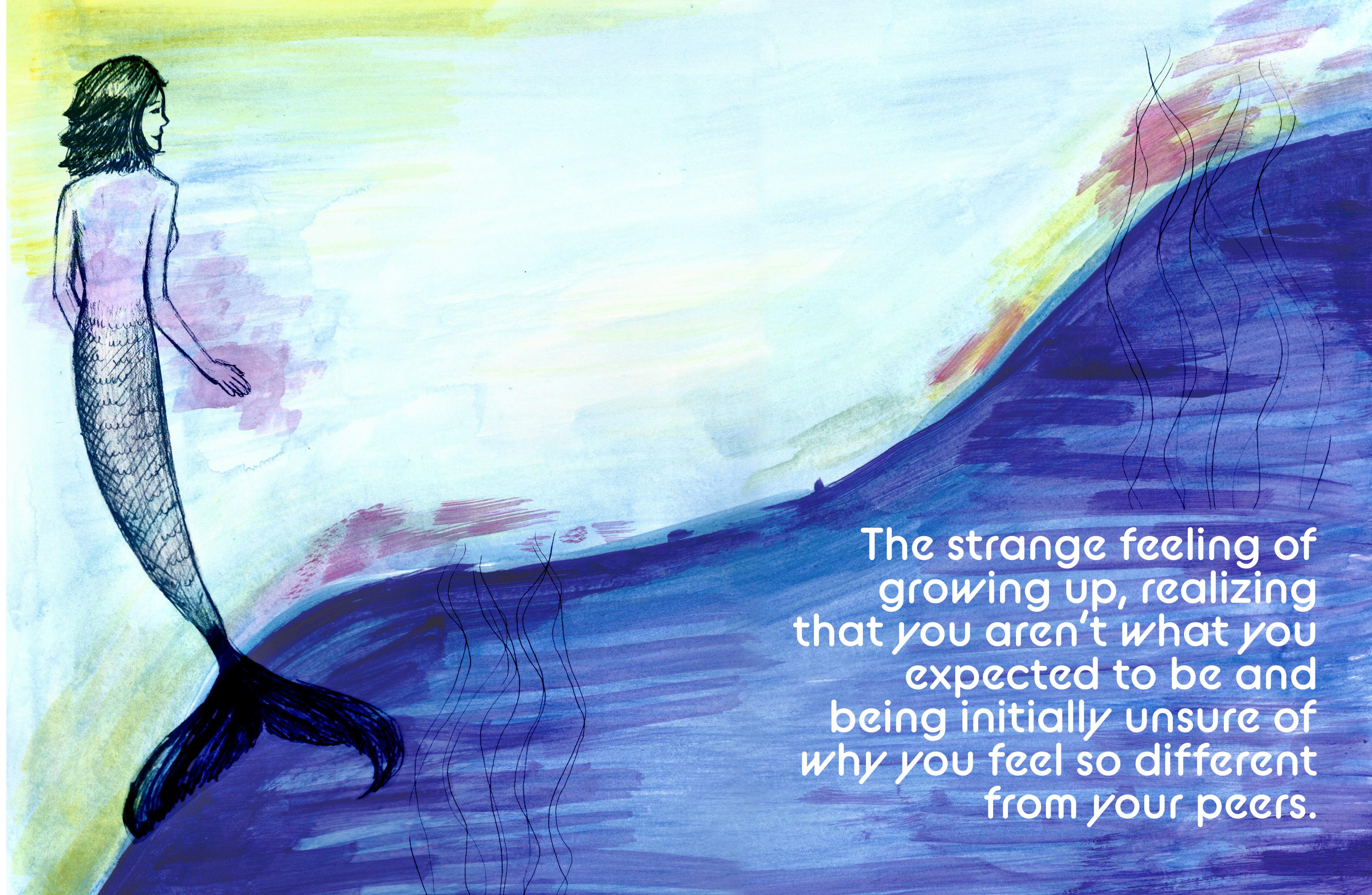
Hawke has never publicly stated her sexuality, but she has made her fondness for her sapphic fans known. In an interview with Flood Magazine, she said, “I think it’s cool that when I play shows, young queer women who love Robin can come and connect to my music too.” In the same interview, she discussed the process of writing her new album, saying, “I’ve gotta go back there: back to puberty, back to my sexuality, back to my education — back to all these things that were mine.”
Her 2022 sophomore acoustic album Moss primarily explores relationships, youth and self-reflection. In anticipation of its release, Hawke posted a link to her Spotify playlist entitled “music for mermaids to kiss to,” potentially referencing the quietly magical and sweetly optimistic closing track on Moss titled “Mermaid Bar.”
In the song, her long-running mermaid allegory is on full display as Hawke tells the story of a lonely, lost soul finding community in otherness.
The song begins in a place of hopelessness:
There was no moon, black sky on the night
I jumped from the bridge toward the river
I swear, I saw silver starlight
On the water’s surface, a shimmer
At the surface level, this opening can be taken as the narrator’s contemplation of suicide. This is an incredibly important subject to explore as young queer people are more than four times as likely to commit suicide than their non-queer peers. A 2022 study conducted by the Trevor Project found that nearly half of LGBT+ youth seriously considered attempting suicide in the past year. By opening the song in this way, Hawke immediately draws an air of melancholic seriousness to the lyrics. She continues:

Pounded the pulse, I couldn’t finish
Didn’t hear a splash or feel the cold
Was full of bubbles for a minute
Turned to ice, then cycloid scales of gold
Turned to ice, then cycloid scales of gold
At this point, the song turns from reality to surrealist escapism. However, the introduction of fantasy into such a serious subject doesn’t diminish its importance, but rather reminds the listener of a way to escape a dark place — by seeking out community.
Hawke’s following description of the song’s narrator turning slowly into a mermaid can be read as a hyperbolic discovery of one’s queerness. The strange feeling of growing up, realizing that you aren’t what you expected to be and being initially unsure of why you feel so different from your peers. For many queer people, the
alienation that the narrator feels is intensely relatable:
My lungs deflated, my fingers weaved Ribs separated for gills to breathe
Ran my tongue over my sharp new teeth
Panicked, swimming, collapsed in the reeds
Taken with the current to the sea Tied disrupting desperate dreams, My belly empty, body weak
The particular line, “Tied disrupting desperate dreams,” calls back to the themes introduced in “To Love a Boy.” It’s the feeling that being queer is a disruption from childhood dreams of heterosexual happiness: a prince charming or a perfect nuclear family.
In the next verse, the narrative shifts from confusion and hopelessness, to slow self-realization. The lyrics show the narrator’s fear of herself and disgust at the instincts arising in her.
When new instincts woke me from the spell
I killed a diamondback terrapin
Was most scared of my awful self
Only at this point does the narrator begin to discover that life goes on, even though she has changed. The music be-
gins to pick up here—the tempo increases and acoustic guitars join in the main melody, creating an instrumental chorus to accompany Hawke’s singing. This instrumentation subtly solidifies the theme of beginning alone, then finding community along the way. One of the only songs on the album that features percussion, a soft beat runs throughout the rest of the song which Hawke described in one interview as a “pulse.” As the song continues, Hawke’s voice grows louder as she becomes more sure of herself. As background harmonies come in, she reaches a turning point in the song.
Also within this verse, the narrator jumps forward in time, past her own self-discovery, instead focusing on her life in the present. She tells how she’s been able to create a place where others like her can gather and find community among other mermaids.
I opened Sardine Dream Mermaid Bar
We serve most oysters and caviar
Leave your seashells in our tall tip jar There are more like me, I swear there are
The last line here is most notable. Community among queer folks is incredibly important, especially for young people who may not have grown up seeing positive representations of happy queer people. The song also provides community for those who have felt isolated from their peers after realizing they’re queer, further proving its importance.
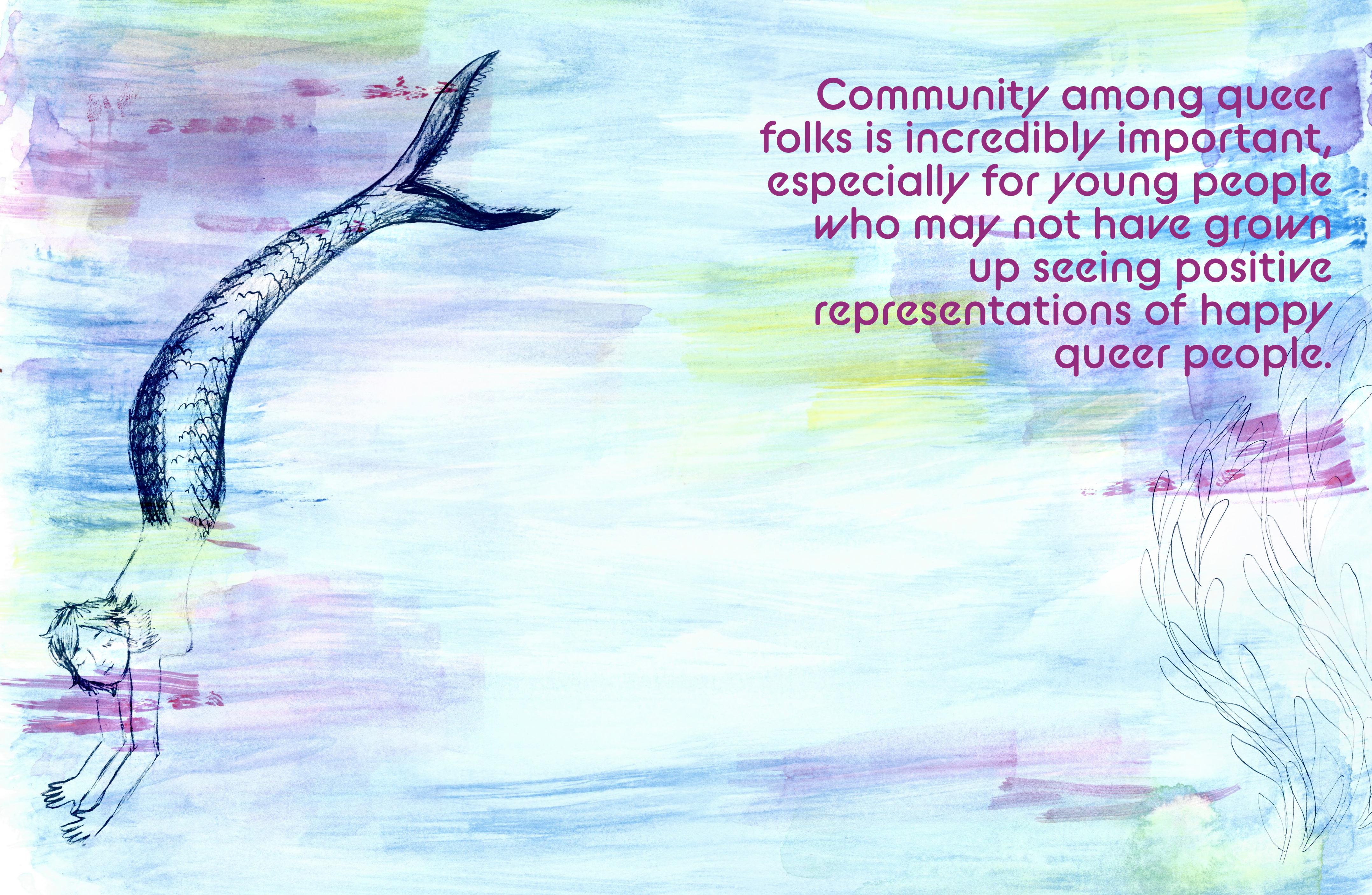
In the book Baby, You are My Religion: Women, Gay Bars, and Theology Before Stonewall (Gender, Theology and Spirituality), author Marie Carter interviewed 85-year-old sapphic woman Myrna Kurtland about her experiences as a lesbian in pre-Stonewall America. An excerpt of the interview reads:
“KURTLAND: Well, I had insomnia. I used to phone up all the gay bars, just to hear them answer the phone… just to hear the noise. Oh yes.
CARTER: So you would call and just be on the phone?
KURTLAND: No, I would just hear the noise and the laughter in the background. I just wanted to be there.”
Following the thread of queer analogy throughout her discography, Hawke’s “Mermaid Bar” can be interpreted as a gay bar. If so, the themes of queer community and inclusion in the song are breathtaking. The verse continues:

Come for scallops, come to hear our song
Come if you’re in awful, bad trouble
Come if you’re certain you don’t belong
Some that fall don’t land in bubbles
‘Cause some that fall don’t land in bubbles
Some fans of Hawke’s music have suggested that “Mermaid Bar” can be viewed as a sequel to “To Love a Boy,” considering both contain similar themes, as well as the shared ocean/ mermaid allegory. The top comment on the “Mermaid Bar” music video on YouTube reads,
“I like to imagine this song as an extended story of ‘To Love a Boy.’” The key difference between the songs is that while “To Love a Boy” is a melancholy lamentation of being different, “Mermaid Bar” is a celebration of those differences and a joyous meeting of others who at one point also felt the same way. While in “To Love a Boy,” Hawke resents her connection to the ocean, “Mermaid Bar” begins with her jumping into the water and surrounding herself with the metaphorical ocean from the earlier song.
It’s nice to think that in four years, Maya Hawke has been able to shift her perspective in this way, positioning herself as someone who could offer her listeners sanctuary from their sadness in her allegorical mermaid bar. g


Stony Brook University’s Mobility and Parking Services (MAPS) sent out an email addressed to the Stony Brook community, revealing their plans to implement a “campus-wide, fully paid parking model.” Within hours, the campus’s classrooms, dining halls and dorms were ablaze with discussions between students—many of them outraged — about how the proposal would affect their finances and education. Less than a week after MAPS sent out their initial email, students mobilized to protest against the proposed changes.
A single line in the email went largely unnoticed by the undergraduate student body: “The details of this tiered parking model were shared today with campus stakeholders, including representation from our various unions and student government.”
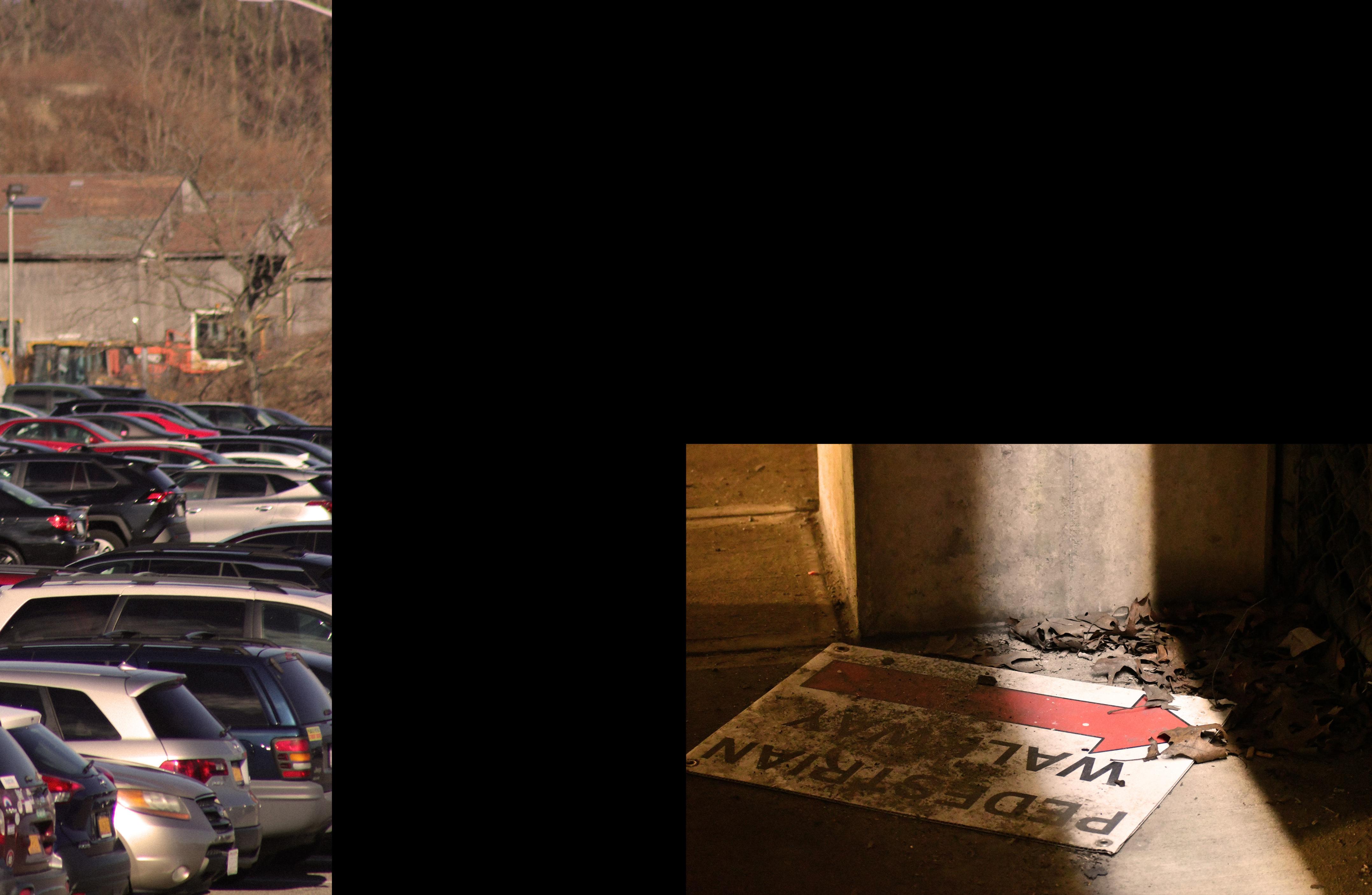
Just four hours before many undergraduates would first skim over the email from MAPS, a group of campus employees gathered at 10 a.m. in the Wang Center to hear an announcement from some administrators. A few of them had some idea of what was coming. Amy Pacholk — a surgical trauma ICU nurse at Stony Brook University Hospital and council leader of the Public Employees Federation (PEF) on campus—felt that a parking fee increase was on the horizon for her and her fellow union members.
“I literally thought they were going to ask us for a $2 to $5 increase,” she said.
Hospital employees, which constitute the majority of PEF members, already pay a little over $16 a month to park in either the parking garages or the flat lots surrounding the hospital. Under the tiered parking plan proposed by MAPS, all employee parking on the hospital campus would be considered either premium or perimeter lots.
“THE WAY THAT THEY’REPUTTING IT IS THAT EVERYBODYWILL PAY TO STAY.”Cars parked in Lot 40. Photo by Jane Montalto.
Based on information obtained by The Press outlining MAPS’ proposal to the union leaders on Feb. 10, the cost of parking in a premium lot would skyrocket to $50 a month, and to $25 a month for parking in a perimeter lot.

“The way that they’re putting it is that everybody will pay to stay,” Carlos Speight, president of Civil Service Employee Association (CSEA) Local 614, said.
“They kept saying, ‘It’s your choice,’ but it’s not your choice if you’re a single parent. It’s not your choice when you’re a student that’s working full-time and going to school.”
CSEA represents about 2,700 university employees — custodial, clerical and maintenance staff, as well as nursing assistants and licensed practical nurses. These employees now face the decision to potentially pay over three times the current price or pay $10 a month to use satellite parking — Lot 40, formerly called South P Lot — and rely on an unpredictable bus schedule that could jeopardize their work performance. In addition to premium, perimeter and satellite
parking, MAPS also intends to charge $40 a month for “core” parking in the heart of West Campus. These prices are the starting point for negotiations with all the university unions and are subject to change.
cated for payroll will increase by nearly $500,000 over the next academic year. However, most of this increase will come from the transfer of some parking enforcement staff salaries from UPD to MAPS, according to Executive Director of Parking and Transportation Kendra Violet. In a presentation at an Undergraduate Student Government (USG) senate meeting on Feb. 16, Violet noted that their team of parking enforcement officers had been understaffed until this semester. Additionally, MAPS recently established new administrative positions to “oversee” operations. She did not outline plans to hire more bus drivers or extend service hours, despite their clear necessity to her proposed plan.
It’s unclear whether the reliability of campus busing will improve as this new plan is implemented. Based on documents from MAPS, the section of their budget allo-
Speight emphasized his safety concerns for employees who work late night shifts having to take a bus in the middle of the night or early in the morning — if the buses will even be running at those times. Currently, buses from Lot 40 only run to the hospital between 7 a.m. and 11:30 p.m. For students and employees who work on Stony Brook’s main campus,
“IT’SNOTYOURCHOICE IF YOU’RE A SINGLE PARENT. IT’S NOT YOUR CHOICE WHEN YOU’RE A STUDENT THAT’S WORKING FULL-TIME AND GOING TO SCHOOL.”A fallen sign in one of the hospital parking garages. Photo by Keating Zelenke.
they stop running even earlier, just before 11:00 p.m.
Apart from safety, Speight also noted the sheer inconvenience that parking in a lot over a mile and a half away from the center of the academic campus and the hospital main entrance poses to employees. “If you have an emergency and you have to leave, now you have to wait for a bus?”
Pacholk expressed a similar sentiment, saying that if employees can’t count on the buses to arrive at the hospital on a strict schedule, their pay period should begin the second they park their cars in the satellite lots, and they shouldn’t be penalized for any potential lateness.
“If people have to take the bus because they can’t afford to park in the garage… that’s when their day starts — period,” she said.
Among the unions present at the Wang Center meeting was the Graduate Student Employee Union (GSEU). Unlike Pacholk from PEF, they had no idea what would be discussed.
“We asked them to send an agenda or some more information,” Doğa Öner, president of the GSEU, recalled. MAPS dismissed the GSEU’s request by explaining this would only be an informational meeting.
This dismissal was characteristic of MAPS’ presentation of this proposal to the campus community. Union leaders from the GSEU, PEF and CSEA Local 614 all expressed that they felt the MAPS administration was either disrespectful, incompetent or both, specifically referencing Kendra Violet and Lawrence Zacarese, the university’s vice president for risk man-
agement and chief security officer. Pacholk said that when she asked if the MAPS administrators understood the strain this change would impose on workers, “they literally shrugged their shoulders, like, ‘Oh, I don’t care, doesn’t matter.’”
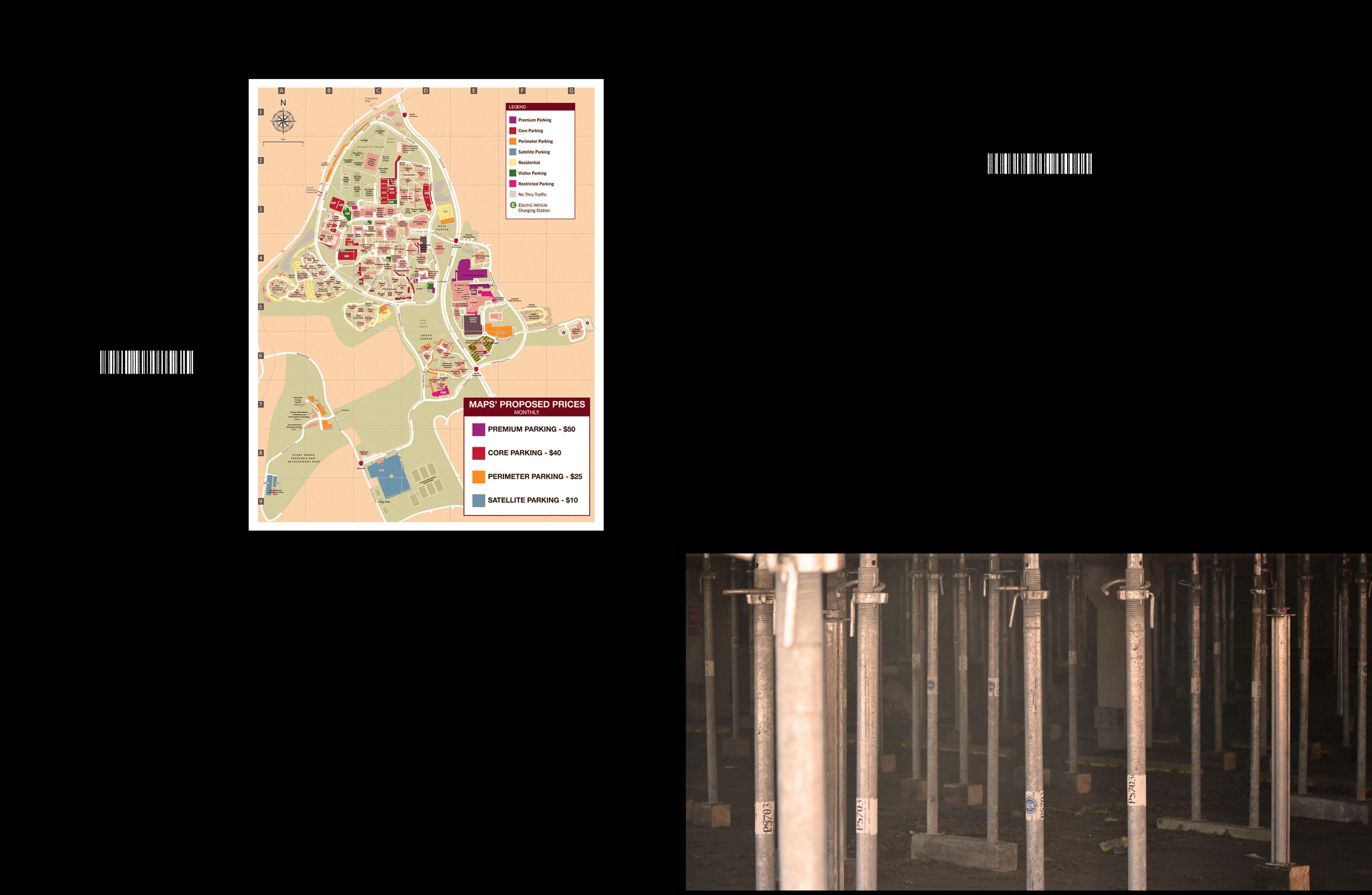
“It was just the straight disrespect in the way we were spoken to,” Pacholk said, explaining why so many union members left that meeting in the Wang Center outraged. “[It was] like we had done something wrong. They were calling us and asking us to increase the rate, right?”
Öner pointed out that MAPS had not been following basic protocols for official negotiations, demanding to schedule their first negotiation with the GSEU less than a week ahead of time. “We need at least 10 business days in advance notice,” he said.
“That’s the common sense procedure for professional communications.”
For the GSEU, paying an additional fee to park is an especially critical blow. Their fight for higher wages has been accelerating for the past two years. Recently, the university admin-
SOME UNION MEMBERS DESCRIBED THE POTENTIAL ENVIRONMENT THIS PROPOSED PLAN MAY CULTIVATE AS A “CASTE SYSTEM.”
istration announced that by next October, they plan to increase the current base stipend for graduate workers to $26,000. While this raise will undoubtedly make a difference in the lives of hundreds of graduate students, it’s ultimately a drop in the bucket on the way to a living wage. In Suffolk County, $26,000 a year still leaves graduate students over $4,500 below the extreme poverty line, according to the Department of Housing and Urban Development. These students are already struggling to afford rent, food, healthcare and other necessities; even an extra $120 a year for the lowest tier of the proposed parking plan is difficult to scrape together. For a parking spot on the “core” of campus, they’re looking at nearly $500. That kind of additional spending simply isn’t an option for most GSEU members — and a number of custodial, instructional, clerical and culinary staff.
“We’re going to be pushed to the periphery of campus, parking at the worst possible spots, making it difficult to work as we need to,” Kaya Turan, an organizer for the GSEU, said. During the meeting in the Wang Center, some union members described the potential environment this proposed plan may cultivate as a “caste system.”
“They’re offering an illusion of choice,
where you can pay more money to park at better areas of campus, closer to the campus center,” Turan said. “For most of our unit, that doesn’t constitute a real choice, because they don’t have the means to be spending the extra money for parking.”
communities, comparatively much closer to the academic mall — students were required to pay over $100 per semester. Violet later revealed that the commuter premium passes were a soft rollout for the fully paid parking model MAPS has proposed for next fall.
If you ask MAPS’ head administrators, their department’s financial woes go back 30 years — that is the narrative Kendra Violet and her colleagues have been presenting to various groups on campus.

MAPS is a fully self-sustained operation. They operate through an Income Fund Reimbursable (IFR) account, where their capital consists of revenue generated via parking tickets, metered parking, hospital employees’ monthly parking payments, grants and money from individual academic departments to cover the cost of parking spaces in lots currently reserved for faculty and staff. Additionally, this past academic year, MAPS implemented a premium parking plan for commuter students, which restricted free parking during regular school hours to Lot 40, on the south end of campus. To park in the commuter lots on the north side of campus — near the train station, behind Student Health Services and around the H and Mendelsohn
This came to light when Violet directly addressed the student body about MAPS’ proposed plan for the first time during the USG senate meeting on Feb. 16. The meeting was originally intended to be in the Student Activities Center (SAC), but moved less than four hours before the scheduled start time to the Alan S. deVries Center on the other side of campus. The last-minute change, once again characteristic of MAPS’ chaotic communication, was done in anticipation of a crowd of students opposing the plan.
Violet stood at a podium in front of the USG senate and executive council — and a group of 10-20 angry graduate and undergraduate students. They looked at her with harsh faces, waiting for the answers they hoped might placate their confusion and outrage. Violet seemed nervous by the end. Perhaps she was intimidated by the onslaught of questions that immediately followed her presentation — intimidated in the way only a person who makes nearly $200,000 a year can be when asking a
“WE’RE FOOTING THE
THEIR MISUSE ANDOngoing construction in one of the hospital parking garages. Photo by Keating Zelenke.
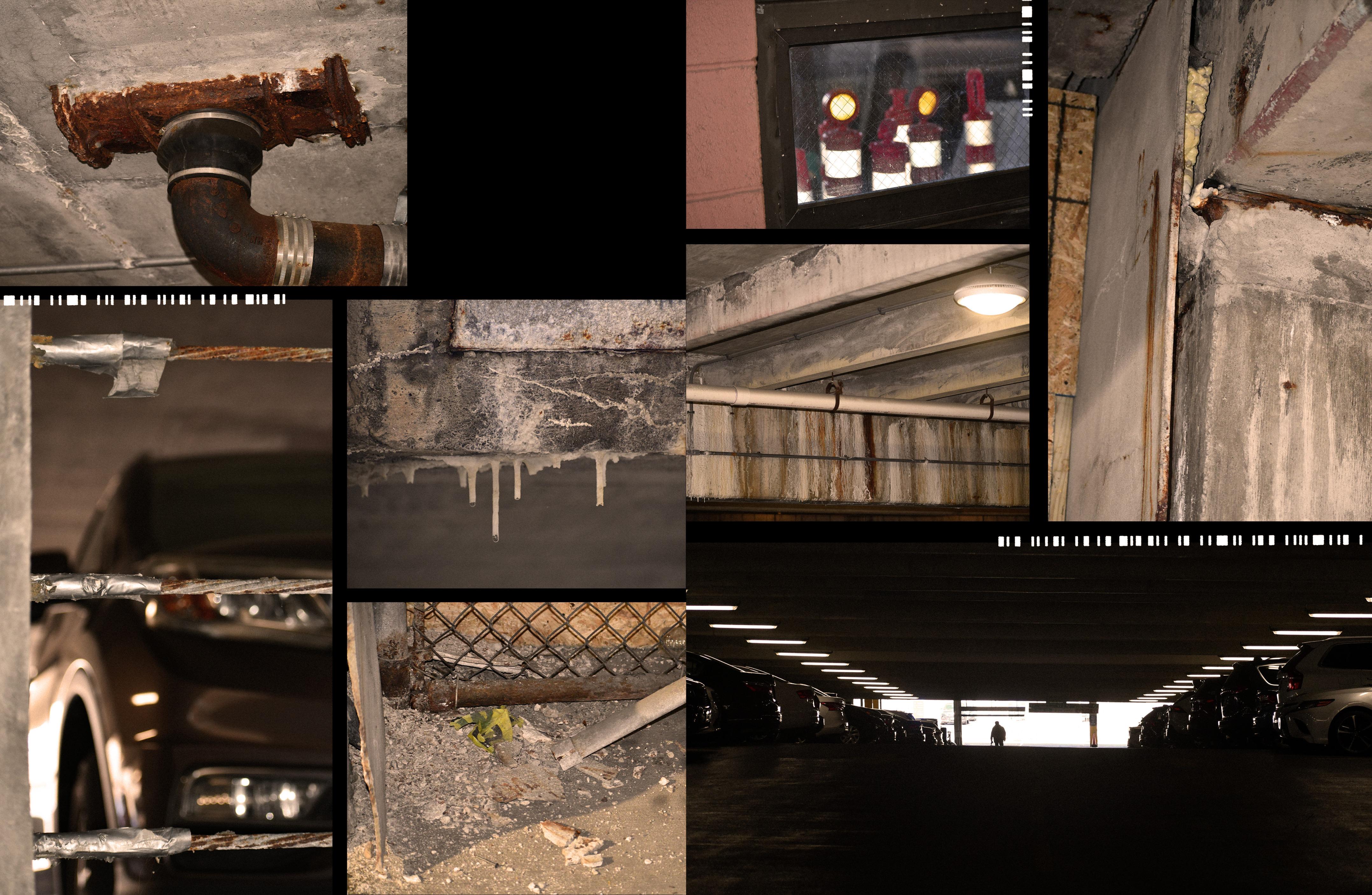
“THEY LITERALLY SHRUGGED THEIR SHOULDERS, LIKE, ‘OH, I DON’TCARE.’”
 Cones in an office in the Administration garage.
Rust and sediment damage in one of the hospital garages. A crumbling wall in one of the hospital garages.
A construction worker in one of the hospital garages.
Photos by Keating Zelenke.
Cones in an office in the Administration garage.
Rust and sediment damage in one of the hospital garages. A crumbling wall in one of the hospital garages.
A construction worker in one of the hospital garages.
Photos by Keating Zelenke.
group of people who regularly struggle to afford basic necessities for more money.
Violet underscored the fact that MAPS receives no funding directly from the university’s administration. As she and her colleagues are quick to cite, MAPS has not increased the cost of parking for students or employees over the past 30 years. Many of their parking facilities are now reaching the end of their functional life and need extensive repairs. The parking situation at the hospital, she explained, is especially dire. In the garages, sediment falls from the ceiling and damages cars. Flat lots and garages alike need their lines repainted.
Additionally, the hospital lots are facing serious capacity issues — Amy Pacholk said she is often unable to get a spot in any of the garages, despite paying monthly for a permit. Carlos Speight said the lots are often so full that hit-and-runs are common.
“People back up and because the parking spots are so small, they back into each other,” he said. “And nobody reports it because there’s not enough cameras.”
MAPS’ planned improvements to hospital parking—including dealing with these capacity issues and more — are projected to cost somewhere around $30 million. With that $30 million plan in mind, plus all of the proposed technology updates and necessary repairs to West Campus facilities, MAPS will be facing an $11 million deficit within three to four years if they do not adjust their business approach. This bottom line was also presented to union representatives during their meeting in the Wang Center on Feb. 10.
“We’re footing the bill for their misuse and misspendings,” Speight said.
MAPS insists in their presentations that this proposed plan would bring Stony Brook in line with similar institutions. However, the parking plans at other large SUNYs, like University at Buffalo (UB) and University at Albany (UA), do not look like what is being proposed for this campus. Undergraduate students at UB pay no additional cost for a permit to park on their campus — the price is included in their broad-based fees. Graduate students there pay only $15 a year. Faculty and staff pay a “nominal” fee in order to obtain their permit.
Students at UA pay an annual parking fee of $50 per vehicle. Albany’s site also mentions a “Comprehensive Service Fee” in their broad-based fees, which helps fund their Office of Parking and Mass Transit Services. Even though Albany and Buffalo operate by charging most — if not all — parking fees within their tuition payment, Stony Brook University does not appear to be considering that option. The current status of the MAPS as a self-funded university service is treated as the sole option.
The only SUNY school whose price holds a candle to Stony Brook’s proposed parking plan is Binghamton University — students pay a little over $140 per year, with a significant discount given to GSEU members. None of these other SUNY schools operate using a tiered parking service like the one Stony Brook plans to implement in the fall.
The first question many students at the senate meeting had for MAPS was why, after 30 years, repairs were only just being done now and all at once. Violet’s answer gave little insight — admittedly, she likely doesn’t have much insight on the issue
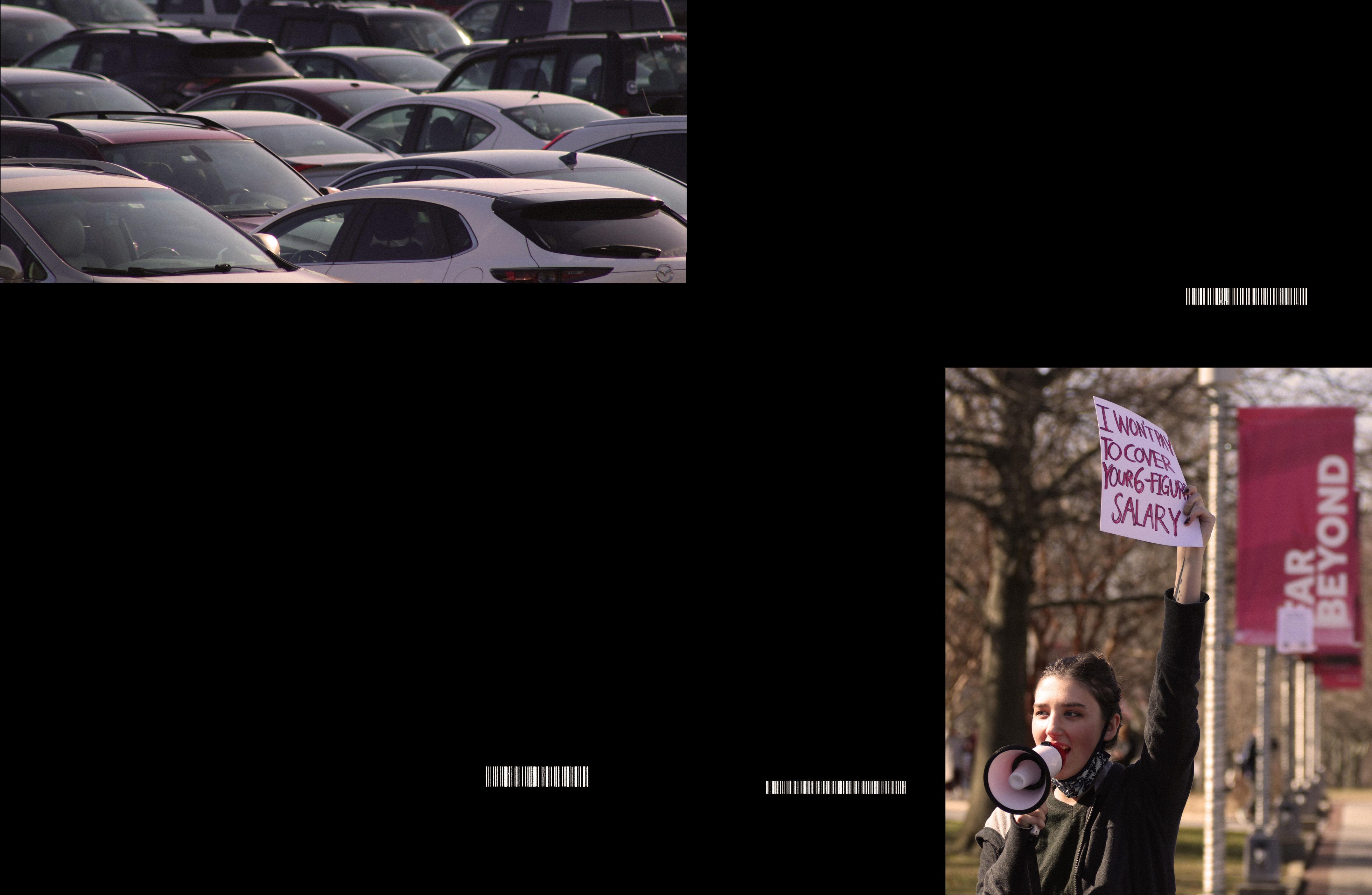
considering she only came to Stony Brook in the fall of 2021. At the union meeting about a week earlier, Speight asked Zacarese a similar question: If hospital workers had been paying about $16.25 a month for 30 years, where had all that money gone?
“He said, ‘I don’t know, I wasn’t part of it,’” Speight said. “But still, you’re accountable because you’re management — you represent management.”
In the face of these deflections, some critics of the proposal ask why the university administration doesn’t help MAPS stay above water. The technical answer is that as a department with an IFR account, MAPS is more or less required to be self-sufficient, never spending more than may make — an IFR account is also pretty much the only reasonable option for organizations on campus that generate outside revenue.
Union leaders pointed out a number of different ways to supplement the cost of repairs without eliminating free parking and sending current parking prices through the roof. Speight suggested that MAPS request a bond from the state. Pacholk claimed MAPS administrators simply don’t want to put the work into applying for community grants that might help them cover the necessary costs.
“There is money for projects like this that exists within both our state and federal government,” she said. “It’s a failure for them to do the work.”
“PEOPLEAREGOINGTOLEAVEOVERPARKING.”Cars parked in Lot 40. Photo by Jane Montalto.
of the Administration Building to protest MAPS’ proposal. Reddit user u/Nuke_bot posted a flyer for the protest on r/SBU, which later gained traction on Instagram — but when the attendees gathered in person, u/Nuke_bot was nowhere to be found. As a result, the protest was “a bit disorganized,” as Matthew Belzer, vice president of SBU College Socialists, put it. It was slated to start at 1 p.m., but this disorganization caused delays.
When it became clear that u/Nuke_bot intended to remain anonymous, other students took charge. They wielded cardboard signs atop the fountain’s ledge — one written spontaneously in ballpoint pen declared, “Piss Off Admin!!”
“M-A-P-S, G-T-F-O,” students shouted as they passed around a megaphone. After about a half hour, the number of protestors slowly increased, and they made their way into the Administration Building to continue their demonstration.
Although they didn’t garner as large a showing as they hoped, the College Socialists remained optimistic. “Small numbers still make an impact,” Amanda Basinger, the club’s president, said. “Active action does work, and if you really put yourself to it, you can accomplish change.” Online, the group created a petition against the increased price.
“You have a lot of power you can hold through organization, and coming together to pressure the administration to not enact these changes,” Öner said.
GSEU collaborated with the College Socialists on a series of protests against “SBU & NY greed” in the spring. Though these protests centered on a living wage for graduate workers and the upcoming SUNY tuition increases, parking was also a significant focus.

CSEA Local 614 also planned two protests against the paid parking proposal — one on Wednesday, March 29 by the Administration Building, and one on Wednesday, April 12 at the main hospital garage. The goal of these protests was unification among all of the unions on campus, as well as the students. “That’s our best weapon,” Speight said.
Both CSEA and GSEU emphasized the power of undergraduate students as one of the largest populations on campus.
“We also ask all undergrads to be aware of their power and come stand in solidarity with us,” Öner said.
sity President Maurie McInnis sat at the head of a long table, sporting her trademark bright red pantsuit, ready to discuss a multitude of issues with student media. She admitted that the current state of Stony Brook University’s parking is not ideal — “Garages that are, we’ll just say, literally crumbling in front of our eyes.” She briefly noted that USG recently proposed the creation of a student advisory group on parking, but offered few specifics as to who would be invited to participate and when it would occur.
McInnis mentioned the loss of faculty and staff over the years as, according to her, tuition hasn’t increased in step with the university’s needs. Since its peak, Stony Brook has reportedly lost almost 100 faculty and 300 staff members as the school has struggled to pay them enough to stay on board.
“You all are starting to feel that, that is really starting to have an impact on your
experience,” she said.
However, regarding whether or not the increased prices for parking will have an effect on faculty and staff, McInnis was visibly surprised to be asked such a question, shaking her head to indicate an adamant no.
“I don’t believe that is any concern at all.”
Despite McInnis’ apparent nonchalance, there is imminent cause for concern for the faculty and staff that keep the university running.
“It’s literally the icing on the cake,” Pacholk said. “It’s the straw on the camel’s back… Literally, people are going to leave over parking.” g
On Monday, Feb. 27, Stony Brook Univer-
Marvel Studios released the second highest-grossing movie of all time, Avengers: Endgame, in 2019. The movie was the culmination of 21 projects, each of which introduced multiple characters within the same central narrative. The movies created a story led by two main characters, Iron Man and Captain America. Nearly every movie had the clashing personalities work together and lead their team against various threats — but in Endgame, both characters die. After massive box-office success with Avengers: Endgame, how does a studio move on? How do you create an interconnected narrative when your main characters are dead?
Marvel Studios answers these questions by hitting the ground running. In the four years after Endgame’s release, they put out 18 projects, known as Phase Four. This phase almost doubled the size of the original franchise, with much less time between each release. The 21 previous films had been released by Marvel over 11 years, starting with the 2008 summer blockbuster Iron Man.
This large volume of new content led many viewers to be overcome by media fatigue. Media fatigue is the sense of exhaustion viewers feel after overstimulation from a certain medium. With the sheer volume of projects that Marvel was producing—a new product to consume every few months — this feeling began to set in for many people. Over time, less people became interested in keeping up with the new movies and shows, resulting in fewer viewers at premieres.

A constant stream of projects from Marvel also revealed a larger industry issue regarding visual effects (VFX) artists. In the past year, many Marvel VFX artists spoke out, saying they were overworked with the litany of projects and strict deadlines.
In an article from Vulture, a freelance VFX artist named Mark Patch spoke of the demands from Marvel when he was asked to work on a project. He knew that Marvel’s demands were outlandish, telling Vulture that a 10-hour show could require double the VFX that a movie might, and on a much shorter timeline. Additionally, Marvel wanted to pay him less despite the large amount of work. Ultimately, he walked away from the contract.
Marvel forces their artists to rush to meet short deadlines. As a result of the time crunch, the quality of visual effects has gone down in Marvel projects, and fans are noticing. Many found Marvel shows like She-Hulk unwatchable due to the character’s jarring animation and unfinished VFX.
Despite the vast amount of content being produced and released by the studio, Marvel’s Phase Four felt empty. In past phases, stories were contained within themselves, yet there was always a tie-in of some sort that made the world feel connected to the greater Marvel Cinematic Universe (MCU). Marvel’s Phase One consisted of origin stories that did not intersect. However, at the end of this phase, Marvel’s The Avengers had neatly tied them all together in a larger connected story.
The studio seems to disregard any need for interconnection in Phase Four. The third project in this phase, Loki, ends with the main character opening up the multiverse — infinite worlds of infinite possibility. Loki’s universe-altering effects are never mentioned again in subsequent projects. The multiverse was brought up again in Spider-Man No Way Home (2021) and in Doctor Strange in the Multiverse of Madness (2022), but these projects never make a meaningful reference to each other, despite Doctor Strange taking place directly after No Way Home. This presents a common theme within the phase:


a lack of cohesion.
Another example of this can be seen in the TV show WandaVision, a story about Wanda Maximoff unconsciously forcing a town of people to live in a perpetual sitcom with a family she created in her mind. The story ends with her learning from her mistakes and understanding the consequences of her actions, sacrificing the family she created in favor of the town’s freedom. Chronologically, Doctor Strange in the Multiverse of Madness is supposed to follow WandaVision. The movie features Wanda as the main antagonist, completely disregarding the character development shown in WandaVision.
Her motivation in Multiverse of Madness is to travel the multiverse to steal her children from another world. Director Sam Raimi even said in a Rolling Stone interview, “I just know that halfway, or maybe three-quarters of the way into our writing process, I’d first heard of this show they were doing and that we would have to follow it…I never even saw all of WandaVision; I’ve just seen key moments of some episodes that I was told directly impact our storyline.” Despite his words, “a proper through line and character-growth dynamic” was exactly what the project lacked, and the villain’s motivation lacked any form of cohesion.
A great way of creating a large, connected story is to feature characters in multiple projects to give the viewers a sense that this world is lived in. When Marvel failed to create that sense by introducing huge inconsistencies within characters, the viewers thought the opposite. The impression left by these characters

make the world feel disjointed.
How does a studio recover from a mixed bag of projects, each struggling to recover the fans’ attention? Marvel responded by releasing their Phase Five and Six movie release slate to get people excited for the future of the MCU. While this news did excite many fans, it equally concerned them. Marvel failed to understand its issue of volume. They announced two new Avengers films that would come out in less than four years. These films would give a central structure to the growing narrative of the MCU, but may not give fans enough time to keep up. Will Phases Five and Six suffer the same fate as their predecessor? Can the MCU save their narrative? The films have all the ingredients for a great story, but fans will have to wait and see whether or not the writing holds up. g
To help in celebrating the “Revisiting 5+1” art exhibit in the Paul W. Zuccaire Gallery, Stony Brook University held a panel in the Student Union Ballroom of alumni and professors to share their experiences at the university in the late 1960s and 1970s. Holding this panel of esteemed and experienced peers helped give context to “5+1” by showing what the university was like at the time of the original art exhibit. As the panel unfolded, it became clear that Stony Brook University’s handling of the Africana Studies Department since its establishment in 1968 has been poorly managed, to say the least, demonstrating a larger issue at the university and within academia as a whole. Systemic racism’s persistence at Stony Brook —
in the psychology department. Now, it occupies a mere two hallways in the Social and Behavioral Sciences building.
Stony Brook’s administration demonstrated through this lack of investment that they were only willing to commit the bare minimum to the Africana Studies Department — if that. While the university itself has not been overtly supportive, efforts made by students and supported by faculty have allowed some Black members of the campus community to thrive. Steps like the return of Black World — the Black and Latino student media publication at Stony Brook since 1974 — to print and this year’s “Revisiting 5+1” exhibit in the Zuccaire
specifically through the underfunding and understaffing of the Africana Studies Department — is a blatant insult to the campus community. Underfunding and mismanagement has led to underpaying professors and decades of broken promises and shameless lies, despite the important and essential scholarship Africana studies contributes to the academic world.
The disrespect and mistreatment of these professors paints a grim picture of the racism Stony Brook aims to eliminate. These issues have gone relatively unnoticed among the broader campus community. The roots of mismanagement run deep, all the way back to Dr. Leslie Owens and his experience as chairman of the Africana Studies Department from 1978 to 2015. When initially asked to take on this role, Dr. Owens explained he felt manipulated and lied to about the extent to which the university would meet him in supporting the department and fostering its growth. He was promised a space where Africana studies scholars could meet and learn from one another, but instead, the program was origi- nally placed with-
Gallery are just a few examples of how these students are fighting for their culture to be seen by the university. Though the weight of representation should not be borne by students, Black and Latino campus community members continually demonstrate that they will not slip into silence.
Both the original “5+1,” exhibition from 1969 and its subsequent revival this past winter demonstrate innovation and individuality in Black abstract art. Perhaps even more importantly, these exhibits represent Black artists, scholars, students and staff members coming together to be heard in an establishment that did not want to listen to them.
Similarly, Black World’s return to print allows Black and Latino voices to be both seen and heard — not only in a single article, but in a publication wholly dedicated to sharing stories affecting Black and Latino communities.
The panel held on Tuesday, Feb. 7 in the Union Ballroom was assembled to help students understand what the campus was like in the late ‘60s and ‘70s, providing historical context to the orig-

BLACK AND LATINO CAMPUS COMMUNITY MEMBERS CONTINUALLY DEMONSTRATE THAT THEY WILL NOT SLIP INTO SILENCE.Photos by Dylan Gallo
 (L to R) Panelists Audrey Fernandez, Deborah BrittonRiley, Mitchel Cohen, Linda Humes, Dwight Loines and Les Owens at an alumni panel on Feb. 7, 2023.
“Untitled,” Jack Whitten, 1968
(L to R) Panelists Audrey Fernandez, Deborah BrittonRiley, Mitchel Cohen, Linda Humes, Dwight Loines and Les Owens at an alumni panel on Feb. 7, 2023.
“Untitled,” Jack Whitten, 1968
 “Untitled (Space Frame),” Howardena Pindell, 1968
“Carnival of Autumn Leaves,” Alma Thomas, 1973
“Hawk’s Return,” William T. Williams, 1969-70
“Untitled,” Al Loving, c. 1969-70
Archival materials from “Revisiting 5+1.”
“Untitled,” Daniel LaRue Johnson, c. 1969
“Untitled (Space Frame),” Howardena Pindell, 1968
“Carnival of Autumn Leaves,” Alma Thomas, 1973
“Hawk’s Return,” William T. Williams, 1969-70
“Untitled,” Al Loving, c. 1969-70
Archival materials from “Revisiting 5+1.”
“Untitled,” Daniel LaRue Johnson, c. 1969
inal “5+1” exhibit.
Among the panelists were a number of Stony Brook alumni who fought for change both on campus and nationally in the 1960s andbeyond.Directlyfollowingthecivilrights movement in the ‘60s, Deborah Britton-Riley came to Stony Brook after dropping out of high school. Britton-Riley described the uni- versity as a refuge from growing crime in Harlem at the time. During her time as a stu- dent,sheco-founded the Black Womyn’sAs- sociation. The comradery she found at Black and Latino student organizations on cam- pus helped her fully experience what Stony Brook had to offer before graduating in 1981.
Mitchel Cohen, Class of 1974, represents the flip side of this coin. A political activist and professional troublemaker, Cohen took part in numerous rallies and protests. Re- minding the panel why activism is not only important but necessary, Cohen cited his own experiences of violence while protest- ing on campus. Cohen’s recounting of law
likeitbroughtalongahugesenseofcommunity for not only Dr. Humes, but the whole Africana Studies Department. Similar to“5+1,”theBlackTheaterClubgaveBlackstudents a space to speak out and find them- selves alongside their peers.
The alumni panel showcased multiple in- stances of Stony Brook’s evolving treatment of Black students and professors. Though each panelist shared some fond memories of support from the university, they also re- fused to shy away from talking about the university’s mistreatment of activists and its broken promises to the Africana Studies De- partment. Despite its setbacks, the departmentisstillactiveandflourishingtothisday. If Stony Brook truly wants to “go far beyond,”asitssloganstates,theadministration needs to not only recognize the mistakes of the past, but actively try to be better in the present and the future. Each piece from “Re- visiting 5+1” is a monument to the struggle of the Black artists who made it—and a cel-
enforcement and Stony Brook security’s un- just treatment of protesters and activists — most notably that of Paul Watson, a Stony Brook student at the time who also found- ed one of the Black Panther chapters in the area. Watson was taken by campus security and beaten for two days in the basement of Suffolk County Police’s Sixth Precinct build- ing in Selden — casting a grim shadow over the treatment of activists on this campus. StonyBrookUniversityflauntsitscapacityto enable social mobility for its students. While this did happen for Deborah Britton-Riley, this is sadly not the norm.
Following Britton-Riley and Cohen, Dr. Lin- da Humes discussed her time as a student atStonyBrookfrom1974to1977.Sheco-founded the Black Theater Club on campus— the first of its kind — and served as vice presi- dent of the Black Student Union. Dr. Humes’ time with the Black Theater Club brought a plethora of respected poets and actors to see on-campus performances by young and bright Black students. The club and others
ebration of those artists’ Blackness. The six scholars who curated the original “5+1” ex- hibit in the ‘60s sparked a much-needed cul- tural revolution on campus at a time when Black voices were fighting to be heard. Its revitalization serves as a reminder that those same voices are present decades later — and still making themselves heard.
It is imperative that there are more oppor- tunities for Black voices to be heard all the time. The recent revival of Black World in print demonstrates a clear platform for dis- enfranchised students, but only time will tell if the Stony Brook administration will send back the same effortthatBlackstudentshavebeen giving for decades. g

EACH PIECE FROM “REVISITING 5+1” IS A MONUMENT TO THE STRUGGLE OF THE BLACK ARTISTS WHO MADE IT — AND A CELEBRATION OF THOSE ARTISTS’ BLACKNESS.


Warning: This article speaks on themes of abuse, cannibalism, murder, grooming and violence.

On her debut album, Preacher’s Daughter, singer-songwriter Hayden Silas Andhedönia journeys through the troubled life of fictional teenager Ethel Cain — the pseudonym under which she released the album. Coated in Southern gothic aesthetics and spiritual motifs, Preacher’s Daughter dissects both the glory and gore of strangers, the religious tolls and the generational traumas that Cain faces. She continuously searches long and hard for slight glimmers of the American dream, but this inevitably leads to her abandonment and gruesome death.
The framework for the overarching story builds with “Family Tree (Intro),” where Cain’s voice echoes as if in an empty church cathedral. Opening with themes of family trauma, she proclaims that “Jesus can always reject his father/But he cannot escape his mother’s blood,” implying that even Jesus will always carry his mother’s genes. Cain expresses how she will forever be tied to her family’s bloodline through the imagery of a noose hanging from an ancestral tree with branches
made of inherited traumas.
Cain’s story begins with the pop-centric coming-of-age anthem “American Teenager,” setting the scene in a small Alabama town called Shady Grove, where the late Preacher Joseph Cain’s legacy lies in the hands of his daughter. Cain immerses herself in the glamor of high school football games and holds Sunday church outings each weekend. She feels out of place in her hometown and wishes to become something that she has no real chance at. She has been losing her faith in God and drowns her sorrows in alcohol to cope with the loss of many people in her life.
Cain reminisces about her relationship with ex-lover Willoughby Tucker in the yearnful and dramatic “A House in Nebraska.” The couple would often fantasize about living peacefully in an abandoned house in the middle of Nebraska —far away from their hometown. Cain pleads for him to come back to their empty “home,” but she knows it will never happen. She laments in her loneliness.
“Western Nights” snaps Cain out of her past fantasies with her ex-lover. Ethel has met a new love interest, Logan Phelps — a man who owns a motorcycle, instigates bar fights and commits bank robberies. Cain is aware that he is a danger to both society and herself, but she sees him as a way of escape:
Hold me across every state line
I’m never gonna leave you baby
Even if you lose what’s left of your mind
She has become greatly disconnected from herself, fully ignoring his faults and viewing happiness as a simple rush of adrenaline. Logan’s heist trails into the following song, “Family Tree,” where the police gun him down, and Cain runs away from the scene. Her ties to her hometown have officially been cut off, having no way to return to Alabama. The noose symbol in “Family Tree (Intro)” now transforms into a weapon she can control, advising herself to “take the noose off, wrap it tight around my hand.” Cain must find a way to live on her own and seeks to wash away her sins: “So take me down to the river and bathe me clean.”
Awash with gospel hums, the gut-wrenching “Hard Times” is a conclusion to the first part of Preacher’s Daughter. Cain reflects on her childhood, when her father tormented her mentally and physically. Stripped of her childhood at a young age, Cain was forced to grow up quickly — “9 going on 18” — and still views her father through a tainted and confusing lens.
The lonesome harmonica in “Thoroughfare” finds Ethel walking alongside an empty road in Texas, where she hops into the pickup truck of a stranger, Isaiah, in hopes to venture out of her rock-bottom mental state. Isaiah tells her about his long journey to California. Throughout the song, the two become infatuated with each other and stay in motel rooms until they reach the coast:
‘Cause in your pickup truck with all of your dumb luck
Is the only place I think I’d ever wanna be
The euphoric cries that close out “Thoroughfare” subside with the start of the promiscuous “Gibson Girl.” The steady incline of volume throughout the track parallels the increasing betrayal of her past religious beliefs, all while Isaiah begins to gaslight her, exploit her and drug her. Rebellion is the catalyst for every action she takes. The untamed rush overcomes Cain, and then cuts out sharply at the end as she begins to succumb to the darkness.
The album takes an even darker turn when a demonic voice speaks in “Ptolemaea.” The title

references a level of Dante’s Inferno, Ptolemy, which houses those who were traitors; Cain feels like a betrayer to her family line. She experiences horrifying hallucinations that distort the appearance of Isaiah. A metaphorical devil possesses him to kill and cannibalize her, and Cain begs him to stop during her final bloody screams for help.
The first instrumental track, “August Underground,” lengthens Cain’s suffering, encompassing her final moments of life and her inability to speak. The aching track implies that the deed has been done, and there is no return to life for Cain. Instrumentals continue with “Televangelism,” which embodies a transcendental form of her lightweight soul, ascending from her body and to the afterlife. The use of piano keys allows the track to feel less gory than the previous one, building a sense of tranquility and nirvana.
Beyond this plane of existence, Cain’s voice returns in “Sun Bleached Flies,” a track depicting her rotting corpse as she reflects on her life:

God loves you, but not enough to save you
So, baby girl, good luck taking care of yourself
Though she found prayer as a remedy for her actions, God never came to stop her from her impulsive choices, and now she regrets all the damage she has done. She concludes the song by yearning for the house in Nebraska — a time when she felt at peace.
In the afterlife, Ethel describes the flesh of her cannibalized body while speaking about the everlasting impact her death will have on her mother during “Strangers.” Since her body was not respectfully laid to rest, she pours out the line, “If I’m turning in your stomach and I’m making you feel sick,” — a play on the phrase “turning in your grave,”—demonstrating the humor she finds in her own death. Ethel expresses her pitiful thoughts for her mother when she finds her daughter’s picture on a milk carton, leaving the album with words of darkened hope:
Don’t worry ’bout me and these green eyes Mama, just know that I love you (I do)
And I’ll see you when you get here g


On Nov. 4, 2022, a free online library with over 10 million free e-books, ranging from children’s picture books to academic textbooks, was shut down for the foreseeable future.
Z-Library was one of the internet’s largest sources of pirated e-books. It was recently seized by the Federal Bureau of Investigation following a series of legal complaints made by The Authors Guild, an organization of more than 12,000 members committed to supporting working writers.
Users who attempt to access this site are now greeted with a screen displaying the warrant of seizure instead of a catalog of this week’s top downloaded books. These types of pirated e-book websites are coined as “shadow libraries.”

Z-Library, often shortened to Zlib, was created in 2009 but gained popularity over the past three years on TikTok with the hashtag “zlibrary.” According to The Authors Guild, the hashtag is reported to have at least four million views.
“Authors generally rely on multiple revenue streams to pull together a living, and they are increasingly exploring new ways to revive out-of-print works when the rights have reverted to them, especially as e-books,” stated a legal complaint issued by The Authors Guild to the Office of the United States Trade Representative (USTR).
Shadow libraries like Z-Library make it more difficult for authors to receive commissions from their books since these sites offer them for free, usually as e-books.
The complaint stated that Z-Library reached a level of notoriety superior to Library Genesis (Libgen), its counterpart shadow library, due to TikTok. The Authors Guild places blame on the social media platform for allowing the popularity of the website to grow.
“We are committed to promoting a safe and positive environment for our users and rights holders. TikTok’s Terms of Service and Community Guidelines… do not allow posting, sharing, or sending any content that violates or infringes someone else’s copyrights, trademarks, or other intellectual property rights,” TikTok wrote in a statement responding to The Au-
thors Guild’s criticism.
The social media platform has since banned and blocked the usage of the hashtag “zlib.”
When readers found out about the seizure of Z-Library, many took to Twitter in outrage, sparking a debate over whether the act was one of government overreach, or rather protection of copyright.
“Zlib gives access to a variety of readers in various countries and social backgrounds. It provides them with the opportunity to learn [things] which they might not have been able to do otherwise,” said Rose Cobalt, an avid reader and former user of Z-Library. “The government getting involved would defeat [its] purpose.”
Fund found that 65% of college students cannot afford their textbooks. With the seizure of Z-Library, they now are pushed to either find alternatives or pay up.
In 2021-2022, the average postsecondary student paid roughly between $400 to $1,470 on books and other academic materials annually. A hard copy textbook can cost up to $400, with an average cost between $80 and $150, according to a study conducted by the Education Data Initiative.
“Zlib was used for academic books by students around the world. University books aren’t cheap — some of them are a few hundred dollars each — and a few thousand dollars each semester is a lot of added burden,” Cobalt said.
In order to pay for these supplies, 25% of students reported working extra hours and 11% of students even reported skipping meals to save money for academic books and materials instead.
Many readers and students have expressed that there is a larger conversation to be had about the Z-Library ban, considering how Z-Library helped lower textbook costs for students, gave people a right to information as well as education and provided books to those in countries where books are not easily accessible.
Despite the seizure of Z-Library, readers are still seeking out alternate shadow libraries — Libgen is a top choice. Since Oct. 29, 2022, Libgen searches have been steadily increasing, while the searches for “bookstores near me” have been decreasing.
In a global era of economic uncertainty and inflation, books are one of many commodities whose prices have been rising. The Consumer Price Index (CPI) reported that from Oct. 2021 to Dec. 2022, the price of recreational reading materials has risen by 4.5 percent and the price of college textbooks has risen 7.6 percent.
Many college students and avid readers turned to Z-Library in an effort to evade the rising costs of all types of books, including textbooks or scholarly books. A study from the U.S. Public Interest Research Group Education
“This website has been created to help many students and book readers, especially those who don’t have access to libraries,” said Manal, a 21-year-old from Bahrain, over text. “Z-Library being taken down has affected quite a lot of people, especially those who don’t have the luxury to buy those books or those living in areas that do not have access to libraries.”
For security reasons, Manal declined to share her last name.
In Bahrain, information remains controlled and restricted by the government. Freedom House, a non-profit organization that conducts research on political freedoms and human rights in countries around the globe, gave Bahrain an internet freedom score of 29 out of 100 due to widespread censorship, numerous barriers to access and insufficient privacy rights.
In an email statement regarding the
Z-Library helped lower textbook costs for students and gave people a right to information.
latest developments of the Z-Library case, Mary Rasenberger, CEO of The Authors Guild, responded to claims from Z-Library users that the site allowed them to acquire expensive academic materials that were otherwise unaffordable.
“The exorbitant cost of education should not be borne by authors and
publishers but by the universities, and it should not be used to justify reliance on foreign criminals for textbooks or trivialize the immense personal and economic harm Z-Library was causing authors,” Rasenberger said.
While the government’s acquisition of Z-Library harms those in the U.S. who cannot afford books, it pro-

tects against copyright and intellectual property infringements. The hope is that readers will be redirected towards legal avenues to purchase these books, benefiting the authors and writers who depend on revenue from book sales for their livelihood.
“The arrest and indictment of Z-Library operators is one of the biggest breakthroughs in the fight against online criminal e-book piracy to date,” Rasenberger said.
With universities requiring students to buy the newest — and sometimes most expensive — edition of their textbooks, students have to search for other ways to save money, especially following the crackdown on shad-
This move demonstrates just how determined they are to keep websitetheir online —
ow library sites. Some ways students may want to consider are buying used books or renting them out and looking for international editions, which are usually 60% cheaper than U.S. editions. Students can also check for Open Educational Resources (OERs, OEMs, or OSMs), which provide course materials specifically designed to be free and accessible to students.
Despite the U.S. government’s intervention and indictment of Z-Library in 2022, the shadow library never went completely down as it continued to operate on the dark web.
“We believe the knowledge and cul-
tural heritage of mankind should be accessible to all people around the world, regardless of their wealth, social status, nationality, citizenship, etc. This is the only purpose Z-Library is made for,” said Z-Library members in a statement.
OnFeb.13,Torrentfreakreportedthat Z-Library has returned to the publicly accessible internet (Clearnet) using a hydra setup. This setup provides each user their own private domain name when accessing the library, making it more difficult for the FBI to locate and eradicate the site. Other websites that offer access to pirated materials have used the same approach to keep their
services online.
“We have great news for you – Z-Library is back on the Clearnet again,” a Z-Library blog post said. “We are already working on making the login page accessible to all users.”
It’s unclear whether this new setup will effectively combat future seizures. However, this move from Z-Library operators demonstrates just how determined they are to keep their website online — and to keep the books in their library free for anyone who may not otherwise be able to afford them. g

and to keep booksthe theirin freelibrary for anyone who may not otherwise be able to afford them.

Purple and orange lights darted between the audience and the empty stage as techno music vibrated against the dark, peeling walls. The crowd eagerly rocked back and forth in their Converse, Docs and Vans, waiting to catch a glimpse of their new favorite band. The beats bolstered anticipation until, finally, five college kids pulled back the curtain and took the stage to raucous applause.
Not many college bands can say their fan bases stretch beyond their campuses. In 2021, rock fusion group Seeing Double started as a passion project to confront quarantine boredom. By the following year, the three songs the group released had garnered millions of streams on Apple Music and Spotify. The unexpected fame kicked the band’s summer into high gear as they scrambled to book a mini tour, shocked by the overwhelming response to their music.
“When we got news that we were playing on a radio station in London, I think that’s when I kind of knew this was really gonna go somewhere,” said Zach Torncello, the drummer for the band.
Mercury Lounge is a small club venue tucked in Manhattan’s Lower East Side. The stage was just big enough to fit the five-member band. After a brief pause to glance at the crowd, the band abruptly counted into their first song as if becoming charged by the electric energy of the room.
The venue shook with each cymbal strike of their newly released, satirical dance hit, “Take It Or Leave It.” The lyrics serve as a relatable, punchy reply to an enemy or a hater. Take it or leave it
My pretty little gift to you
You’ve got an answer
For every little thing I do
When you cry you sharpen my knife, I’m not cutting slack
The band was visibly floored to see that the crowd knew every word of their latest release. Seeing Double material-

ized from the vision of lead singer and bassist Allie Sandt. She began searching for band members when the pandemic deterred students from moving back to her dorm at SUNY Oneonta. Sandt met fellow members, guitarist Mike Aaron, backup vocalist and percussionist Ali McQueeney, drummer Dylan Travison and guitarist Zach Torncello on campus. All the musicians but McQueeney are studying music at the state school.
The group started off playing gigs at their local bar Oneonta Armory, rotating stage time with fellow Oneonta bands there and venues around town.
“It’s a really supportive community. All of us are friends and we all hang out,” said guitarist Mike Aaron.
It wasn’t long until the ‘70s-inspired hit “Leah” blew up on TikTok. Thousands of
people began using the song in their videos, placing the band on the map. As of April 2023, “Leah” has reached nearly 4 million streams on Spotify.
“We would show up in the middle of nowhere in Pennsylvania, and there were people there that knew ‘Leah.’ It was just crazy,” Aaron said.
However, booking venues outside of Oneonta wasn’t easy. Aaron recalls the booking process for their summer as a really stressful time. Most issues stemmed from the fact that some venues are 21+ — an age milestone that the band members themselves hadn’t reached.
“I think I emailed maybe upwards of like 100 venues along the East Coast—starting up in Maine and ending in Maryland — and maybe out of 100 you only hear back from 20,” he said.
Despite the road bumps, the band hit the road, making stops in major cities including Syracuse, Philadelphia and New York City. They ended their tour with a sold-out show at New York City’s oldest rock club, The Bitter End.

“It was so weird walking out and seeing so many people. They were all cheering and there was a lot of family too, which was really nice,” McQueeney said.
At the Mercury Lounge, fans were treated to an electric 35-minute set — an impressive feat given that Seeing Double has yet to release a debut EP or album. Between songs, McQueeney led the band
in a touch up, whipping out hairspray to spruce up their styles.
The group mixed in some well known covers into the setlist, adding their own twist to each one. Their harmonies on Fleetwood Mac’s “The Chain” lingered in the air for a few seconds before their accompaniment filled the silence. Sandt and McQueeney provided the vocals — with help from Aaron — as the packed audience danced and sang along.
In club venues, encores are never guaranteed. However, Seeing Double returned to the stage to play a song whose lyrics fit perfectly with the venue’s backdrop. It took mere seconds for the crowd to recognize the beginning notes of Harry Styles’ “Kiwi.”
“It’s New York, baby, always jacked up,” the room sang along.
Between their chilling vocal harmonies and impressive musicianship, Seeing Double rivals bands that have been in the industry for years. While Sandt is currently the only songwriter, she trusts that the band’s chemistry both in the studio and on stage could easily translate into successful group songwriting sessions.
At the merch table, fans were able to meet the band members, creating a uniquely intimate experience at a crowded show. The long line cemented their promise for future success.
Since August 2022, the band has played
in the city multiple times, most recently returning to The Bitter End on St. Patrick’s Day. They also released a new song, “Bygones,” in early November.
As the members simultaneously pursue their college degrees, they continue to play locally around their school. In March, they posted in honor of Seeing Double’s two-year anniversary. The caption thanked their fans—doublers—for streaming their music and continuing to follow their journey. g


President Joe Biden’s personal residence in Wilmington, Delaware, was thoroughly searched by Department of Justice investigators earlier this year. According to an FBI agent on the scene of the investigation, President Biden’s eyes widened as a classified document was pulled from between his couch cushions. The president furrowed his graying eyebrows.
“Oh my,” the president said. “I forgot I stuck that one in there. Ha!”
The agent brushed the dust and chip crumbs to the carpet, watching President Biden’s eyes gaze lovingly towards the markings of classification on the documents.
“I couldn’t believe what I was seeing,” said Special Agent Rick McDocFinder, in an exclusive interview with The Press. “We’ve got a real epidemic brewing here. These classified documents are presidential kryptonite.”
He spoke in reference to former President Donald Trump, who is facing scrutiny for similar addiction issues. The 45th president continues to refute claims that he too struggled to leave classified documents in their rightful places.
We spoke with the former president regarding a search warrant issued for his residence at Mar-a-Lago, located in Palm Beach, Florida. Following a search of the former president’s home on Aug. 8, 2022, the Federal Bureau of Investigation found over 325 classified documents.
“No, no, no, no, no,” Trump said. “You’ve got that all wrong — these were all borrowed. They were misplaced! This is an act of sabotage.”
When asked if he suspects anyone in particular who may have planted hundreds of classified U.S. documents in his private residence, the former president simply stated, “Democrats.”
Our reporters noted that a number of classified documents slipped out from Donald Trump’s pant leg on his way out the door. The documents have been returned to governmental authorities for analysis.

Trump’s former physician and retired U.S.
Navy officer, Dr. Sean Conley, was contacted to shed light on whether or not Mr. Trump struggled with mishandling classified documents during his time in office. Dr. Conley stated that when the former president tested positive for COVID-19 in 2020, his medical staff endured bouts of outrage over classified White House documents.
“As he was being transferred to Walter Reed Military Medical Center, we noticed he had all of these papers sticking out of his pockets. We told him he could leave all of his presidential business behind for now, as the current priority was his health, but then he called me a huge embarrassment, amongst other things, so we let him take the documents to the treatment center,” Dr. Conley said.
Dr. Conley then told our reporters that the former president is in “optimal health,” and all claims suggesting addiction and abuse of classified U.S. documents are “insane and untrue.”
“I never saw him with any form of documents, not even his own tax forms,” Dr. Conley said, just moments later.
While Mr. Trump remains under investigation, his former White House counterpart, Mike Pence, has been grappling with similar struggles. A couple of months ago, his residence in Indiana was searched for five hours by the FBI, where one classified document was found illegally in the former vice president’s possession. Mr. Pence could not be reached for comment on the recent situation but is allegedly complying with the authorities.
FBI Agent Rick McDocFinder, who is growing sadly accustomed to finding classified documents in improper hands, worries that these recent discoveries of addiction to classification run deeper through the U.S. political system than currently known. He suspects that high-ranking U.S. politicians have been stuffing classified information in their briefcases for years.
“Every U.S. political echelon was probably doing it back in the ‘50s, but precedent doesn’t make this acceptable now. These politicians need serious help,” he said. g

It’s probably because I’m a whiz at mashing up a banana and slathering its mushy sweetness onto toasted, peanut butter-coated slabs of Ezekiel bread. Once I unite the two slices together, I securely wrap the sandwich in aluminum foil like I’m bundling up my future toddler in her coat, earmuffs and mittens to then scoop her up and head out to brace the winter wind.
It’s my dad’s recipe.
While we were leaning against the counter at the ice cream parlor, my boyfriend said I’m his Tree Hugger. We had been gaping at the never-ending list of sundae flavors, but that decided it: we’d get the Tree Hugger sundae and split it. The ingredients were all favorites of mine: a mound of vanilla bean ice cream1 sprinkled with crumbled pecans2 and maple syrup dribbling3 from its peak. Plus, not one, but two cherries on top.
More boyfriend-original nickname entries dated Sept. 8, 2022:
Sometimes it’s just Greenie.
Green is my color. It reminds me of trees. The scooper at the ice cream parlor complimented me on my, at the time, just-bought forest green chicken shirt. A shirt that doesn’t feature just one, but 10 chickens: five per row. My boyfriend says I’m cool because during Zoom meetings, I hike through the woods sporting my chestnut Ray-Ban sunglasses with the tops of the trees as my background. I don’t think much of it, other than that it’s my preferred environment. I like to move.
Other times, he calls me Green Bean.
When I was in preschool, Mrs. Brazeau told my dad that I loved green bell peppers. I’d discovered them during snack time. So, Daddy started buying green peppers for me. He’d slice them into thin strips, the length of about four three-year-old bites, and pack them in stackable Rubbermaid plastic containers, the ones with brick red lids. My boyfriend doesn’t know that. Maybe he’d call me Green Pepper if he did.
On Fridays I would get a treat: Nocciolata4 smeared on one slice of whole wheat bread cut into rectangular halves. My homemade school lunch. I guess I became a Sandwich Girl at an early age. g


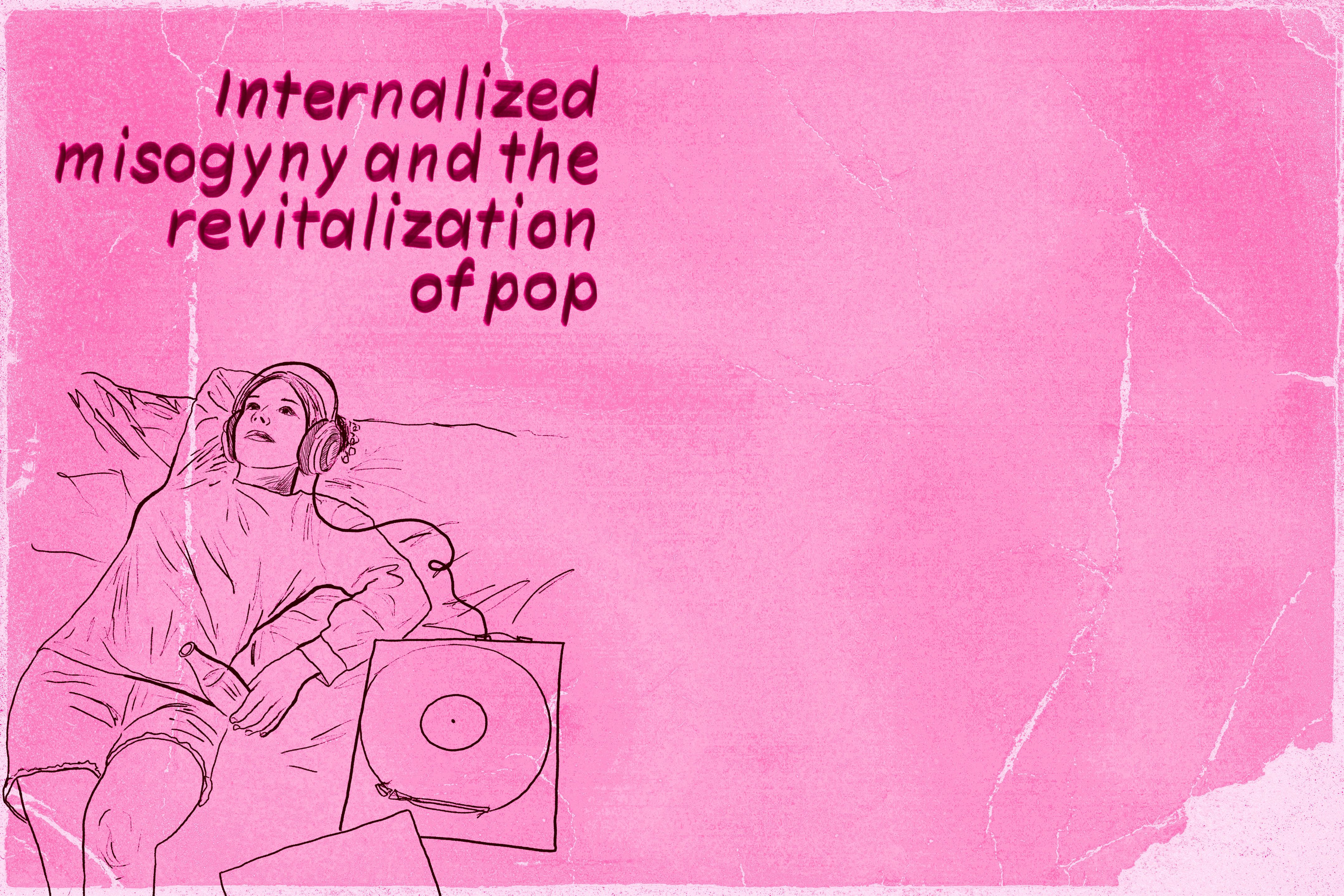
in June 2022, alternative indie pop band MUNA released their third album, MUNA. The album is their first under Phoebe Bridgers’ label, Saddest Factory Records. “Life’s so fun, life’s so fun/Got my miniskirt and my rollerblades on,” lead vocalist Katie Gavin belts in the chorus of lead single “Silk Chiffon.”
This is in stark contrast to the visceral lyrics listeners are privy to in songs like “Crying on the Bathroom Floor,” from MUNA’s 2017 album, About U. “Give me your disrespect/Give me your pain and loneliness,” the band lamented.

MUNA reinvented themselves with MUNA. Where therewasonceanangry,politicallychargedqueerband teetering on EDM beats, there is now unadulterated sass, fun and glee associated with the trio. MUNA’s newfound identity in their recent album is not an isolated incident.

Take Lorde’s uplifting psychedelic pop record Solar Power. The New Zealand singer described the 2021 release as her “weed album.” With dreamy vocals over a groovy, beachy instrumental, a verse from the title track sums up her transition from the poignant Melodrama to her newest record:



forget all of the tears that you’ve cried, it’s over it’s a new state of mind are you coming, my baby?Illustrations by Komal Grewal
Most notable of the new wave pop projects is Taylor Swift’s Midnights, the revitalized and bejeweled love child of her earlier records, 1989 and reputation. Swift’s vocals are huskier — Lana Del Rey-esque — her lyrics are slyly sexual and her wine of choice is cheap rosé. Now 32, her work is more mature, but just as jovial. On fan-favorite “Karma,” Swift sings in layered vocals:


sweet like honey karma is a cat purring in my lap ‘cause it loves me flexing like a goddamn acrobat me and karma vibe like that
MARINA, formerly known as Marina and The Diamonds, has also matured. Her 2012 persona was adorned with hearts, bubblegum and pin-up curls while singingbleaktalesofteendom—thinkeatingdisorders, male validation, profound loneliness, etc. — on Electra Heart. On the other hand, MARINA now sports fruit and flowers in her music’s imagery, while searching for her divine femininity through anthemic tracks like “Man’s World,” from her latest album Ancient Dreams In A Modern Land. Both fun and empowering, she sings like a siren somewhere between a floaty soprano and her throaty, lower register:



After years of melancholic records dominating the charts such as SZA’s Ctrl, Lana Del Rey’s Norman fucking Rockwell!, FKA Twigs’ MAGDALENE and Taylor Swift’s folklore, why are these light-and-sweet projects having a long-awaited return now?


Let’s start with what led us away from the early ‘00s and ‘10s pop and towards the yearnful records that prevailed from 2016 to 2020.
Radio pop’s downward spiral began with a negative attitude towards the general mainstream that festered on social media and grew over time. Being “basic” — enjoying cultural trends like pop music — was frowned upon.





For a long time after its 2010 release, Katy Perry’s Teenage Dream felt like a guilty pleasure to me, as did a lot of similar music, like Lady Gaga’s The Fame, or Britney Spears’ Circus. At the end of the year, they were some of my top artists. However, when people asked who my favorite artists were, I’d list names far from Katy Perry.
The Smiths. Soundgarden. System of a Down. Stone Temple Pilots. Those were the artists I named instead. And don’t get me wrong — I love these bands. But my so-called guilty pleasures weren’t woven into that list for a reason.
i’m a strawberry soda raise my lashes to heaven stars in my hair running like a waterfall i don’t wanna live in a man’s world anymore
Internalized misogyny is characterized by experiencing sexist thoughts or enacting sexist behaviors upon oneself, often subconsciously. A common symptom is the infamous “I’m not like other girls” mentality. By streaming some of the light-hearted, chart-topping albums I mentioned, I was exactly like other girls, but I didn’t want others to know. I wasn’t alone in this thought process either.

Following a career-changing controversy involving Kanye West in 2016, Swift’s reputation — the title of the record she released one year later — was tarnished. She experienced a mass resurgence of supporters with the release of her folk sister albums, folklore and evermore. Intricate, wistful lyrics characterize the duo. These were her first alternative albums after over a decade of country and pop releases.

Suddenly, it was cool to be a Swiftie again. Girls like me, who had once shied away from listening to Swift’s discography — at least openly — were now able to express their admiration of the pop star without fear of the word “basic.”

Alongside Swift’s near-abandonment of pop, COVID-19 ensued. She released these albums in July and December of 2020. Not only was sweet, poppy music not “in” anymore, it was almost distasteful in the face of a worldwide lockdown.



A 2021 study found that depressive symptoms in U.S. adults tripled immediately following quarantine mandates. Naturally, musical themes of isolation and melancholy accompanied mid-pandemic releases. Because of their relatability, woeful records dominated the charts, bumping bubblegum pop down several

Now, in 2022, most COVID-19 restrictions have been lifted, though not without contention. The reintegration of normalcy and social gatherings into everyday life has remedied the feelings of loneliness and depression that came with quarantine.
“Bag on my side ‘cause I’m out ‘til dawn/Keeping it light like silk chiffon,” Katie Gavin sings. It’s safe to say that people are eager to get back outside and embrace the sensuality of life, as upbeat records like those of MUNA, Swift, MARINA and many more pioneer the era of post-lockdown music.
While Lorde’s Solar Power perfectly fit the postlockdown music era themes, it was arguably released too soon for most. By June 2020, New Zealand announced that there were zero existing COVID-19 cases across the nation. Upon the album’s August 2021 release, the rest of the world was still riddled with the virus.

Thus, New Zealand-born Lorde’s refreshing new album was not nearly as relatable as Pure Heroine or Melodrama. In fact, Melodrama sold more than twice as many copies as Solar Power, which was met with harsh criticism upon release.
Internalized misogyny, another contributor to the stifling of pop music in the mainstream, still exists. It evolves with time, manifesting in social media discourse and trends. However, as the phrase “internalized misogyny” becomes more commonly known, the

Bynamingandunderstandingthediagnosis,itbecomes easier to detect one’s own symptoms. I don’t remember where I first heard the words “internalized misogyny” used, but I do remember coming to the understanding that I didn’t like half of the things I told myself I did — I’d just been told for so long that mainstream, usually

When I was 13, I was deemed a “feminazi,” among a number of other names, by boys at my school as I expressed my early support for the fourth-wave feminism that was beginning to flood mainstream discourse. I let this affect me more and more as I got older. Over time, I had unknowingly become less

It took years to come to the conclusion that if I listened to the external voices reprimanding me for being feminine, internalized misogyny would follow. When I did stop listening, though, I felt a weight come off my
The revitalized pop beats of the post-quarantine era are not as ubiquitously joyful as the revered dance tunes of the ‘00s, but there is an overarching theme: following
on my side
‘cause I’m out ‘til dawn keeping it light like silk chiffon
